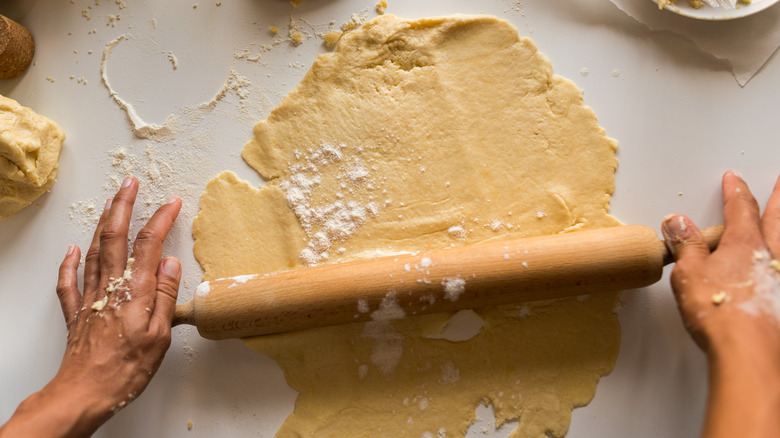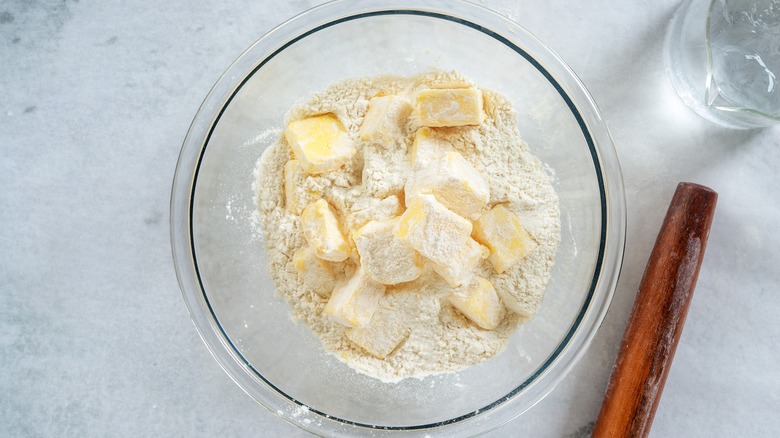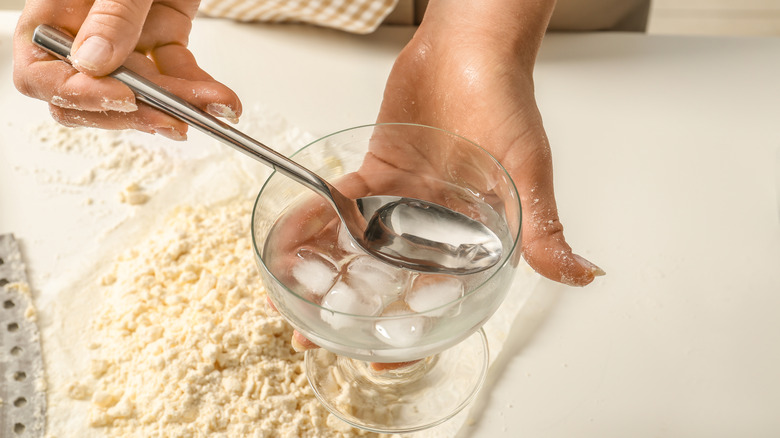The Ziploc Ice Hack That Makes Rolling Out Dough So Much Easier
"Keeping dough cold will make it much easier to roll out" is a truism that many bakers know. While it's pretty easy to keep dough cold if the weather is complying, what if you're hankering for a baked treat on a warm day?
Many recipes will encourage you to transfer the dough to the fridge multiple times in between steps so that it can chill. Surely there must be a way to avoid the back-and-forth schlepping that can save you time in the kitchen. Try instead to bring the cold to your counter. Simply lay bagged ice on your work surface to cool it down. Leave your bagged ice on the counter for at least 10 minutes to chill it, then wipe off the condensation on the counter before turning your dough out. Your dough is now instantly easier to roll out, especially if the dough is also chilled!
This tip will work with regular bagged ice from your corner convenience store or home freezer. However, if you foresee baking regularly, it may be worth it to use a large Ziploc freezer bag instead. Fill any size Ziploc bag with just enough water so that it will lay flat when zipped shut, then place it on a sheet tray so that it gets frozen flat in the freezer. This way you have a counter-chiller bag of ice at the ready whenever you need to roll out dough.
The simple science behind keeping dough cold
Even if your dough is cold, when you try to roll out dough on a warm day (or in a warm kitchen), you'll find out pretty quickly that the dough has a higher chance of sticking to the counter, the rolling pin, and even your hands, making it incredibly difficult to work with, and even causing tears. Dusting the work surfaces with flour will work up to a point to prevent sticking, but you don't want to add too much flour to the dough either. Making the work surface as cold as possible is therefore the best added insurance.
Not only does working with chilled dough prevent sticking, but possibly the more important element is that cold dough helps keep the structure and shape of your final baked goods, especially when they contain fat. Chilling the dough keeps the fats in your dough in a solid state, and whether you're mixing pie dough for a flakey crust, or cookie dough for a thick and chewy cookie, solid fat is crucial. According to The Guardian, when dough enters the oven, "a race will start between the sag of melting fat and the drying of the structure-forming gluten network." Simply put, the colder the fat, the slower it will melt before the gluten around it has a chance to set into its desired shape.
Even more cool tips for dough
So you can chill the dough, and chill the countertop. What else can you keep cool to ensure the best possible results for your dough? The answer: Literally everything that's involved in the process of making dough.
Other ingredients in your baked goods can also be chilled, especially the water that's added to the flour — many recipes call for ice water. The flour itself can be stored in the refrigerator and used as needed, and comes with the bonus of keeping nasty flour weevils at bay.
A cool rolling pin will also help tremendously. Some bakers have stainless steel rolling pins that they store in the freezer until ready to use. There are also hollow rolling pins that are filled with water before being placed in the freezer, ensuring icy-cold contact. Keeping a basin of ice-cold water nearby to dip your hands in between handling the dough manually will help keep the warmest thing in the room (you) cool; just remember to quickly pat them dry before touching the dough so it doesn't become too wet.
Colder ambient temperatures can definitely make a difference, too. If it's possible, work on the dough in the coolest part of your house, or have the A/C or fan going to keep the temperatures as low as possible — and voila! You have perfect dough every time.


